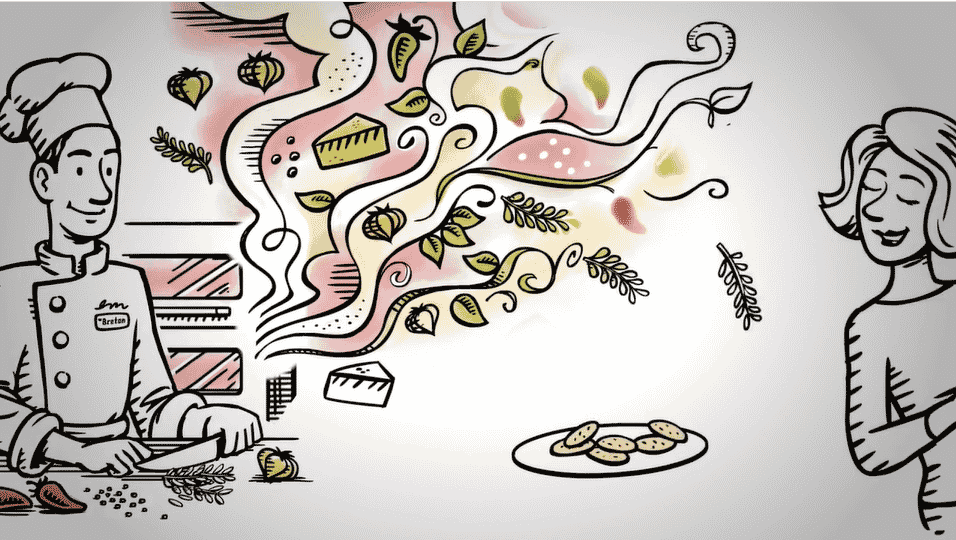Although whiteboard videos are well known for their iconic black-and-white aesthetic, many include a splash of color. Used thoughtfully, color can help call attention to important ideas and make your videos more interesting. But that doesn’t mean you should add color randomly. If you’re thinking about using color in whiteboard video, make sure you’re adding it in the right places.
Every whiteboard video is a balancing act. On one side of the scale is the simplicity that makes whiteboard video a powerful medium. You have to balance that simplicity against the need to provide enough visual cues to convey your message. We’ve collected our top tips for getting this balance just right when using color in whiteboard video.
1. When adding color to whiteboard video, less is more
You don’t need a lot of color. You don’t even need color in every frame. The best videos alternate between frames with color and those without. That way, the color makes an impact every time it appears.
When you think about it, it’s easy to see how adding a few touches of color can make a big difference. But in the midst of the production process, you might feel the urge to fill in whiteboard images like the pages of a coloring book.
Take a look at this frame of a whiteboard video we made for Venmo. Notice how the color subtly calls attention to the brand logo without distracting from the action.

2. Color Can Help Highlight Your Brand
The subtle example above wasn’t the only time we used color to highlight the Venmo brand. In that whiteboard video, we used color everywhere the logo appeared.

In the few cases when something other than the logo has color, you can use the same palette to maintain consistency. It’s a subtle way to infuse brand identity into your whiteboard videos.
3. Color Can Also Bring Text to Life
You include text in your whiteboard videos because you have something important to say. Usually, something that’s hard to convey with images alone. Adding a touch of color can help draw attention to your text. You can either color the text itself…

Or surround and highlight that text with colored elements…

4. Use Color to Build Familiarity
People prefer the familiar. It’s a basic fact of human psychology. Adding color to your videos can help familiar objects stand out. And when you associate your brand with familiar objects, brands, or logos, you help the viewer feel more comfortable with your business and your message.
In this whiteboard video we created to promote the Rangers App for the Madison Square Garden Company, we used color to highlight the Facebook, Twitter, and Instagram logos. We could have used the black and white versions, but then viewers’ eyes might have slid right past them.
Including the familiar brand colors helped create a link between these well-known apps and the new Rangers App. They could download and use the new app just like other apps they were already comfortable with.
5. Showcase Product Images with Color
You might have noticed that product images pop up several times in the example above. Adding realistic imagery to a whiteboard video can sometimes be jarring. When drawings exist alongside photographs, the difference in style may distract the viewer. Carefully implemented color can help bridge that gap.

Notice how the reds and blues in the drawings help tie the image together. You’re not staring at the hyper-realistic smartphone in a black and white world. Instead, you’re taking in the whole image, just as our animators intended.
6. Color Can Punch Up the Action
The magic of whiteboard videos is that they don’t really move all that much. As the hand draws and the lines resolve into recognizable figures, viewers get the illusion of movement. Color can enhance this effect. As the black and white illustration is colored-in, the transformation can convey story and action.
Take the opening sequence we created for the eighth season of Showtime’s Weeds:
Our goal was to quickly convey key plot points from the first seven seasons of the show. So we needed a way to efficiently pack a lot of storytelling into just a few seconds. Color helped make it possible.
For a house fire, and a poolside death:

7. Color Can Set an Emotional Tone
Most successful animated videos create a rich environment. They make you feel like the characters are moving through a world that has depth and dimension. Although whiteboard videos offer a stripped-down version of the world, a touch of color can help set a mood.
Notice how the subtle coloring in the background of this frame enhances the sense that the character is sad and defeated, maybe even bored by her food choices:

Compare that to the warm and inviting tones of the frame below. You can almost smell the rich aromas of this kitchen:

Both frames are from whiteboard videos for Dare Breton Gluten-Free Crackers. Both use a similar color palette. But the way color is used helps set two different emotional tones for these videos.
8. Give Characters Personality
Whiteboard videos are a popular way to explain complicated processes. Many processes involve people, either directly or indirectly. Adding color to a character can help the viewer understand how the person relates to the process.

For example, in this video we created for Prologis, we wanted to show that a whole team of individuals is involved in making this process work. If everyone was drawn in black and white, you might see them as simply a crowd of people, rather than recognizing that each one has a unique role to play.
9. Use Color to Humanize Characters
But what if your main character isn’t human? Color can help here too. Colorizing non-human characters can help them seem more alive and relatable. Take a look at the Data in the screenshot below.

10. A Color Pop Pinpoints The Point
Because color draws the eye, coloring in one element helps the viewer decide where to focus. In the screenshot below, we’ve colored the question mark to drive home the point that our main character is making a choice.

Using Color in Whiteboard Video
Making smart color choices can help convey your main idea, highlight your product, or help viewers connect with your message. You don’t have to apply all of these tips in one video. Remember tip #1: Less is more…except when it isn’t.
It’s possible to create an effective whiteboard video in full color. Like the Know Better Bread video below, your full-color whiteboard video will end up looking more like a graphic novel, and less like whiteboard animation. But that might be the right choice for your brand.
For help creating a whiteboard video that catches viewer attention, contact the whiteboard video experts at IdeaRocket. From colors to characters, we can help you design a video that launches your message into orbit




